Search Result
Results for "
bacteriostatic antibiotic
" in MedChemExpress (MCE) Product Catalog:
18
Isotope-Labeled Compounds
| Cat. No. |
Product Name |
Target |
Research Areas |
Chemical Structure |
-
- HY-W002677
-
|
|
Antibiotic
Bacterial
|
Infection
|
|
Fluoroquinolonic acid is a bacteriostatic antibiotic. Fluoroquinolonic acid has broad-spectrum activity against Gram-positive and Gram-negative bacteria .
|
-
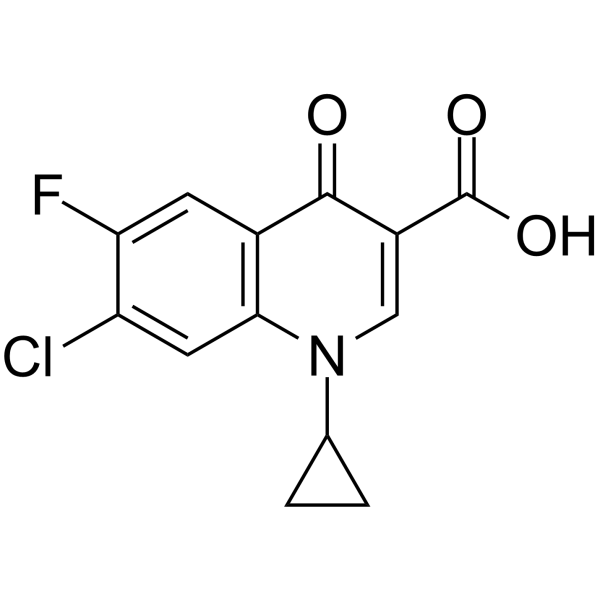
-
- HY-B0322S1
-
|
|
Antibiotic
Bacterial
|
Infection
|
|
Sulfamethoxazole- 13C6 is a 13C labeled Sulfamethoxazole. Sulfamethoxazole (Ro 4-2130) is a sulfonamide bacteriostatic antibiotic, used for bacterial infections. Sulfonamides is a competitive antagonist of para-aminobenzoic acid (PABA)[1].
|
-
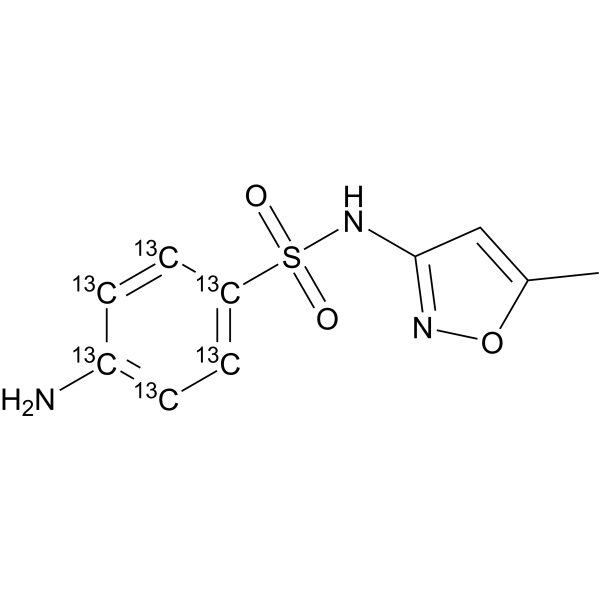
-
- HY-B0479S
-
|
Thiophenicol-d3; Dextrosulphenidol-d3
|
Isotope-Labeled Compounds
Bacterial
Antibiotic
|
Infection
|
|
Thiamphenicol-d3 is a deuterium labeled Thiamphenicol. Thiamphenicol, a methyl-sulfonyl derivative of Chloramphenicol, is a broad-spectrum antimicrobial antibiotic. Thiamphenicol acts by binding to the 50S ribosomal subunit, leading to inhibition of protein synthesis and bacteriostatic effect (against Gram-negative, Gram-positive aerobic and anaerobic bacteria)[1][2].
|
-

-
- HY-B0322A
-
|
Ro 4-2130 sodium
|
Bacterial
Antibiotic
|
Infection
|
|
Sulfamethoxazole sodium (Ro 4-2130 sodium) is a sulfonamide bacteriostatic antibiotic . Sulfamethoxazole sodium is used to treat various urinary tract pathogens and in combination with Trimethoprim is considered the gold standard in the treatment of urinary tract infections (UTIs) .
|
-
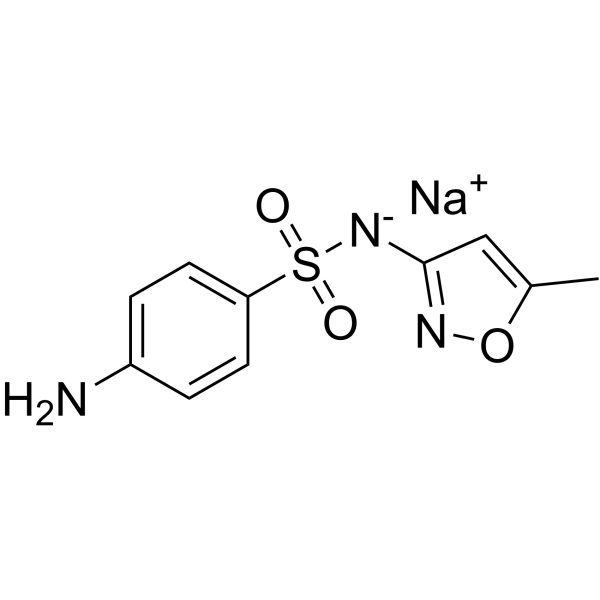
-
- HY-121300
-
|
(-)-TAN2162
|
Antibiotic
Bacterial
Endothelin Receptor
CGRP Receptor
|
Infection
Cancer
|
|
Kendomycin ((−)-TAN 2162) is a polyketide antibiotic with remarkable antibacterial and cancer cells cytotoxic activities. Kendomycin tends to be bacteriostatic rather than bactericidal and inhibits the growth of the methicillin-resistant Staphylococcus aureus (MRSA) strain COL at a low concentration (MIC of 5 μg/mL). Kendomycin is a potent antagonist of the endothelin receptor and a calcitonin receptor agonist which plays its role as an anti-osteoporotic agent .
|
-
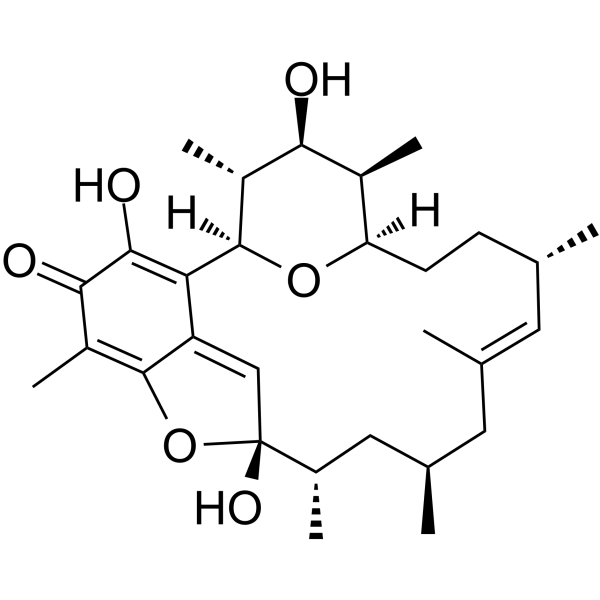
-
- HY-101575
-
|
Acetylkelfizina; Acetylsulfamethoxypyrazine; FI6073
|
Bacterial
Antibiotic
|
Infection
|
|
Acetylazide is a synthetic broad-spectrum bacteriostatic antibiotic.
|
-

-
- HY-B0322S
-
|
Ro 4-2130-d4
|
Bacterial
Antibiotic
|
Infection
|
|
Sulfamethoxazole-d4 is a deuterium labeled Sulfamethoxazole (Ro 4-2130). Sulfamethoxazole is a sulfonamide bacteriostatic antibiotic[1].
|
-

-
- HY-N7123
-
|
Sulphacetamide
|
|
|
|
Sulfacetamide (Sulphacetamide), a bacteriostatic sulphonamide, is a popular antibiotic prescribed for treating ocular infections .
|
-
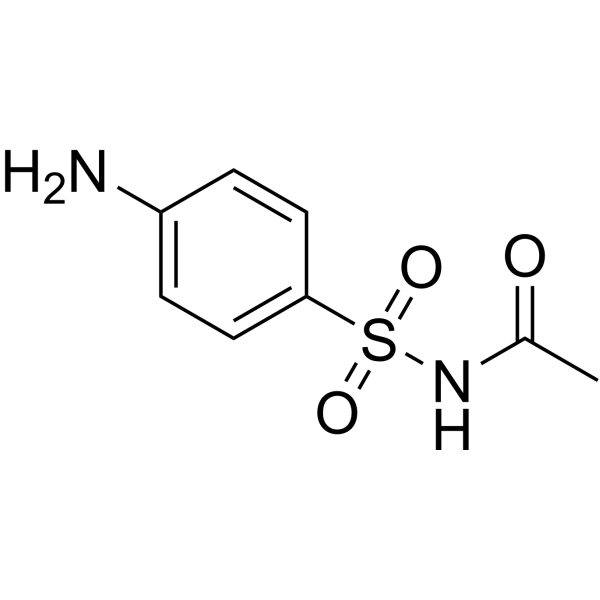
-
- HY-B0322
-
|
Ro 4-2130
|
Bacterial
Antibiotic
|
Infection
|
|
Sulfamethoxazole (Ro 4-2130) is a sulfonamide bacteriostatic antibiotic, used for bacterial infections. Sulfonamides is a competitive antagonists of para-aminobenzoic acid (PABA) .
|
-
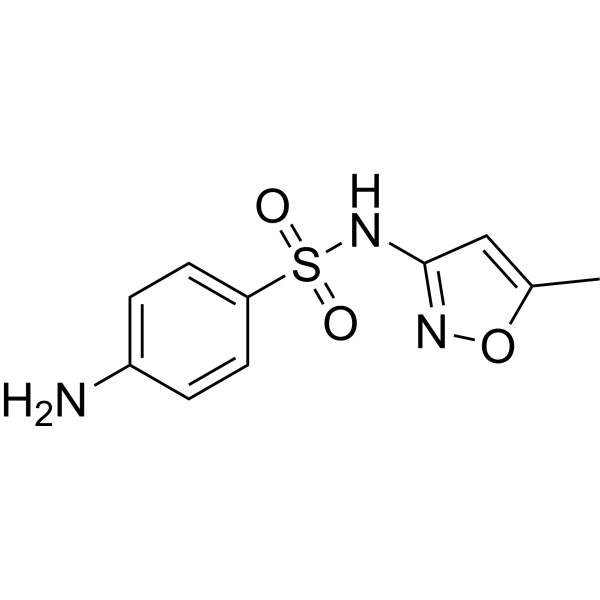
-
- HY-N7123S1
-
-

-
- HY-N7123S
-
|
Sulphacetamide-d4
|
Isotope-Labeled Compounds
Bacterial
Antibiotic
|
Infection
|
|
Sulfacetamide-d4 is the deuterium labeled Sulfacetamide. Sulfacetamide (Sulphacetamide), a bacteriostatic sulphonamide, is a popular antibiotic prescribed for treating ocular infections[1][2].
|
-
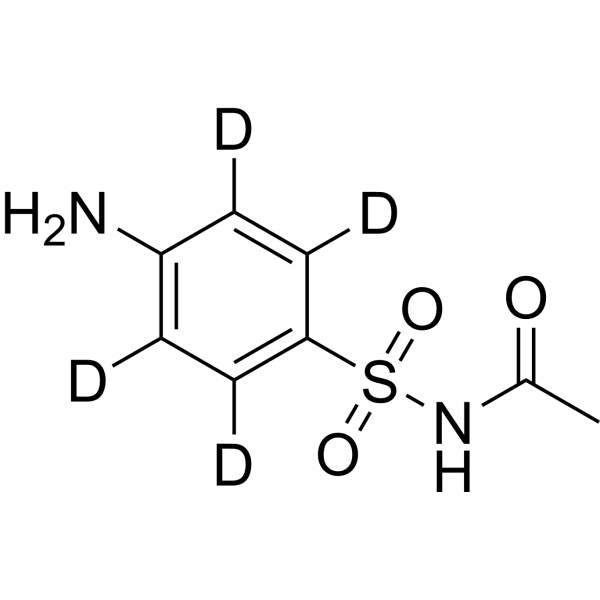
-
- HY-W013266
-
|
Acetylsulfamethoxazole
|
Bacterial
|
Infection
Metabolic Disease
|
|
N4-Acetylsulfamethoxazole (Acetylsulfamethoxazole) is a metabolite of Sulfamethoxazole (HY-B0322). Sulfamethoxazole is a sulfonamide bacteriostatic antibiotic, used for bacterial infections .
|
-
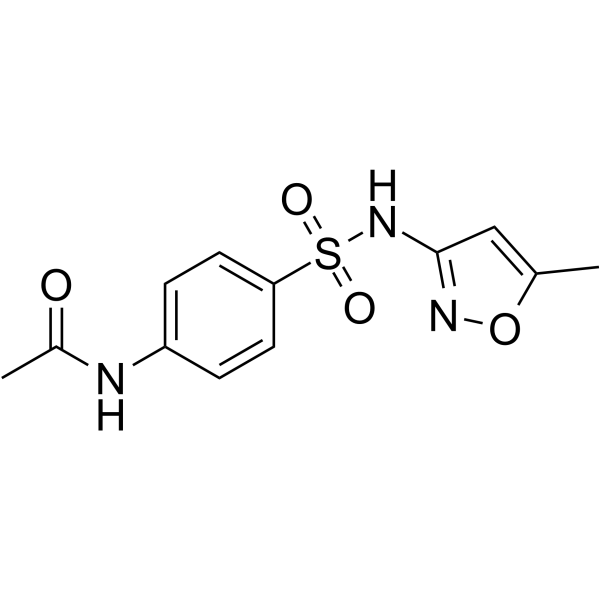
-
- HY-19581
-
|
|
|
|
|
Baquiloprim, an antibiotic, is a selective inhibitor of bacterial dihydrofolate reductases. Baquiloprim possesses in vitro bacteriostatic activity against both Gram-negative and Gram-positive bacteria .
|
-

-
- HY-N7123R
-
|
Sulphacetamide (Standard)
|
Bacterial
Antibiotic
|
Infection
|
|
Sulfacetamide (Standard) is the analytical standard of Sulfacetamide. This product is intended for research and analytical applications. Sulfacetamide (Sulphacetamide), a bacteriostatic sulphonamide, is a popular antibiotic prescribed for treating ocular infections .
|
-

-
- HY-G0016
-
|
MADDS; Monoacetyldapsone
|
Drug Metabolite
|
Others
|
|
N-Acetyl dapsone (MADDS) is the major metabolite of Dapsone (HY-B0688). Dapsone is an orally active and blood-brain penetrant sulfonamide antibiotic with bacteriostatic, antimycobacterial and antiprotozoal activities .
|
-
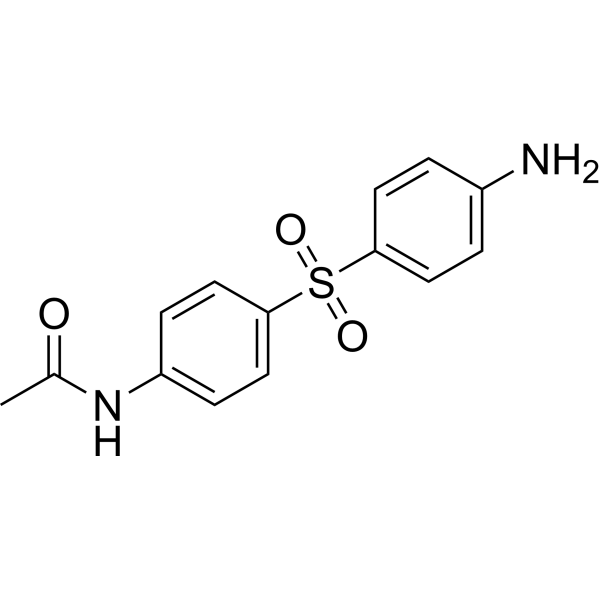
-
- HY-19581S
-
|
|
Isotope-Labeled Compounds
Antibiotic
Bacterial
|
Infection
|
|
Baquiloprim-d6 is deuterium labeled Baquiloprim. Baquiloprim, an antibiotic, is a selective inhibitor of bacterial dihydrofolate reductases. Baquiloprim possesses in vitro bacteriostatic activity against both Gram-negative and Gram-positive bacteria[1][2].
|
-
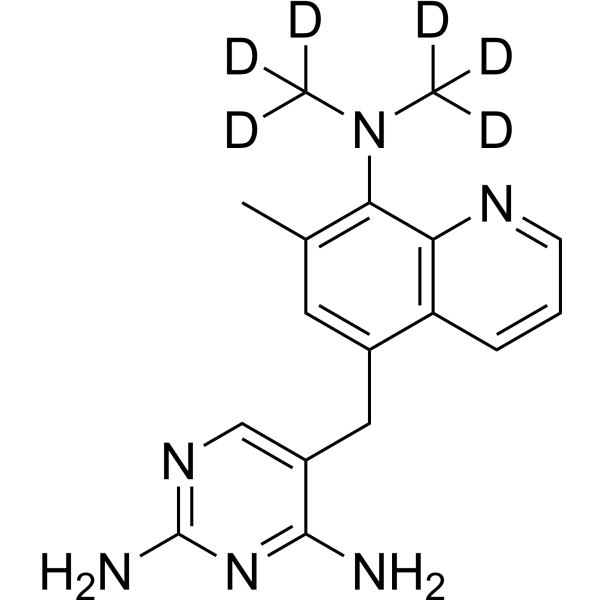
-
- HY-B1350A
-
|
Sodium fusidate; SQ-16360
|
Bacterial
Antibiotic
|
Infection
Cancer
|
|
Fusidic acid sodium salt (Sodium fusidate), a bacteriostatic antibiotic produced from the Fusidium coccineum fungus, belongs to the class of steroids. Fusidic acid sodium salt has no corticosteroid effects. Fusidic acid sodium salt inhibits the growth of bacteria by preventing the release of translation elongation factor G (EF-G) from the ribosome .
|
-
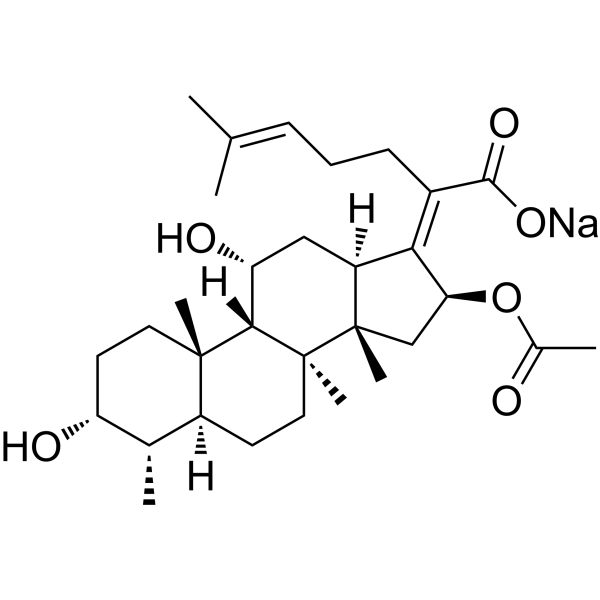
-
- HY-B1350
-
|
Fusidate; SQ-16603
|
Bacterial
Antibiotic
|
Infection
Cancer
|
|
Fusidic acid (Fusidate) a bacteriostatic antibiotic produced from the Fusidium coccineum fungus, belongs to the class of steroids. Fusidic acid has no corticosteroid effects. Fusidic acid inhibits the growth of bacteria by preventing the release of translation elongation factor G (EF-G) from the ribosome .
|
-
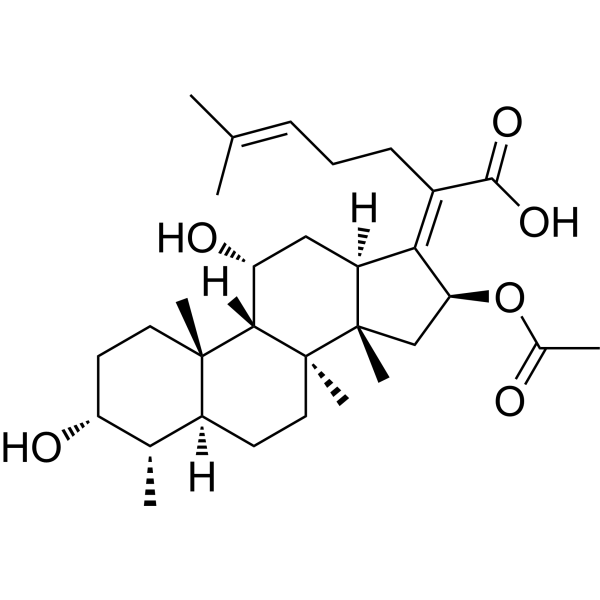
-
- HY-B0479
-
|
Thiophenicol; Dextrosulphenidol
|
Beta-lactamase
Bacterial
Antibiotic
|
Infection
|
|
Thiamphenicol (Thiophenicol), a methyl-sulfonyl derivative of Chloramphenicol, is a broad-spectrum antimicrobial antibiotic. Thiamphenicol acts by binding to the 50S ribosomal subunit, leading to inhibition of protein synthesis and bacteriostatic effect (against Gram-negative, Gram-positive aerobic and anaerobic bacteria) .
|
-
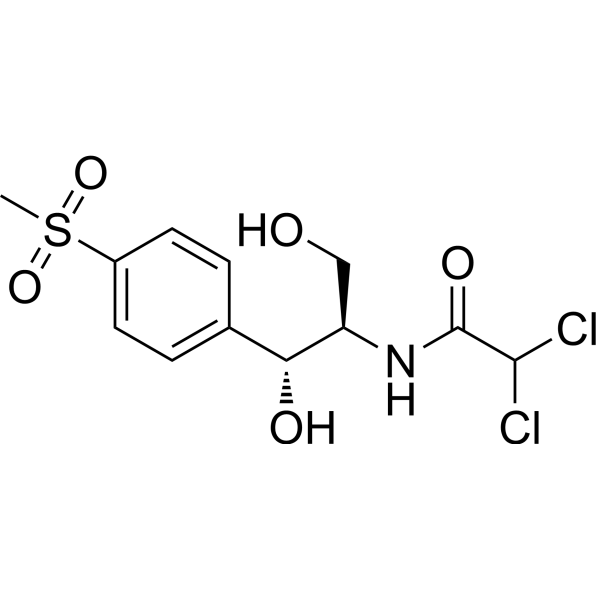
-
- HY-B0398
-
|
|
Bacterial
Antibiotic
Topoisomerase
|
Infection
|
|
Nalidixic acid, a quinolone antibiotic, is effective against both gram-positive and gram-negative bacteria. Nalidixic acid acts in a bacteriostatic manner in lower concentrations and is bactericidal in higher concentrations. Nalidixic acid inhibits a subunit of DNA gyrase and topoisomerase IV and reversibly blocks DNA replication in susceptible bacteria .
|
-
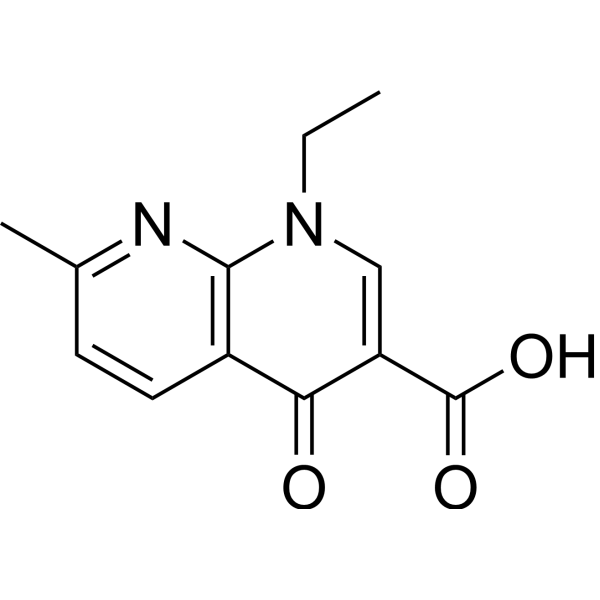
-
- HY-128384
-
|
|
Bacterial
|
Infection
|
|
Benzyldodecyldimethylammonium chloride dihydrate is a quaternary ammonium compound (QAC) and can be used as a biocide to target antibiotic-resistant bacteria, such as methicillin-resistant Staphylococcus aureus (MRSA), multidrug-resistant (MDR) P. aeruginosa et. al. Benzyldodecyldimethylammonium chloride dihydrate, an antimicrobial agent, bacteriostatic or bactericidal properties depending on the concentration.
|
-
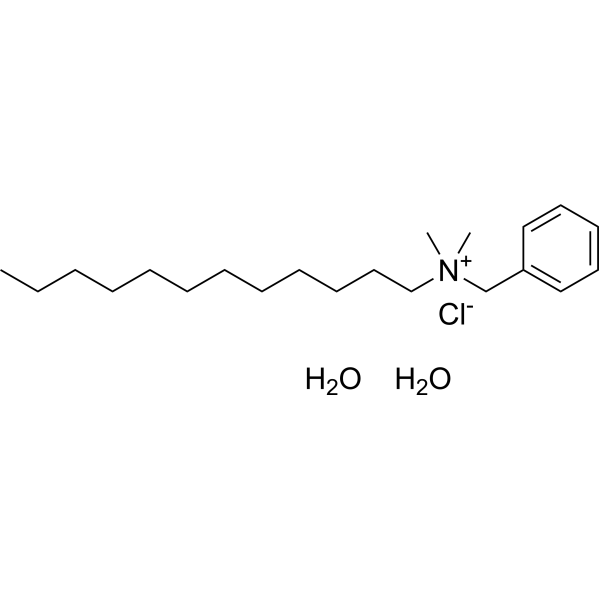
-
- HY-146503
-
|
|
Bacterial
|
Infection
|
|
Antibacterial agent 86 (Compound A11) is the most active and displays bacteriostatic activities against methicillin-resistant S. aureus, with MIC values as low as 0.00191 μg/mL, which is 162 and 32 times lower than that of the marketed antibiotics tiamulin and retapamulin, respectively .
|
-
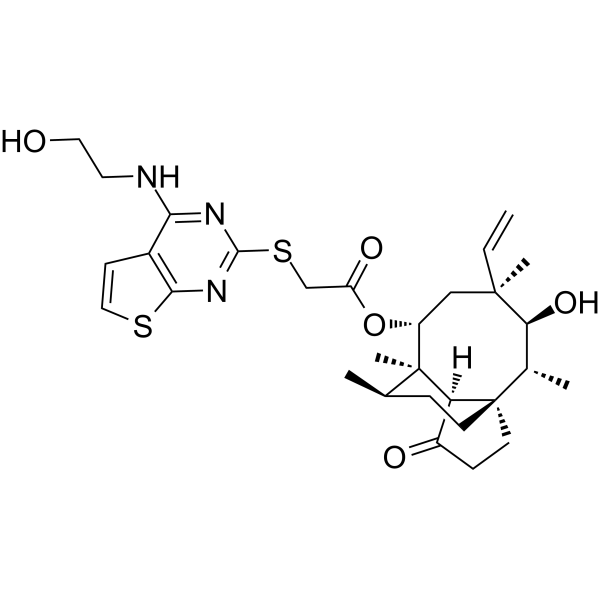
-
- HY-B0398A
-
|
|
Bacterial
Antibiotic
Topoisomerase
|
Infection
|
|
Nalidixic acid sodium salt, a quinolone antibiotic, is effective against both gram-positive and gram-negative bacteria. Nalidixic acid acts in a bacteriostatic manner in lower concentrations and is bactericidal in higher concentrations. Nalidixic acid inhibits a subunit of DNA gyrase and topoisomerase IV and reversibly blocks DNA replication in susceptible bacteria .
|
-
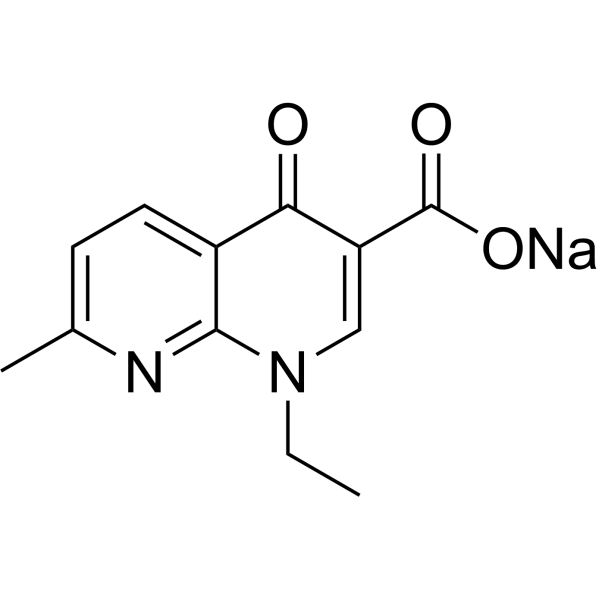
-
- HY-W013266S
-
|
Acetylsulfamethoxazole-d4
|
Bacterial
|
Infection
Metabolic Disease
|
|
N4-Acetylsulfamethoxazole-d4 is the deuterium labeled N4-Acetylsulfamethoxazole. N4-Acetylsulfamethoxazole (Acetylsulfamethoxazole) is a metabolite of Sulfamethoxazole (HY-B0322). Sulfamethoxazole is a sulfonamide bacteriostatic antibiotic, used for bacterial infections[1].
|
-
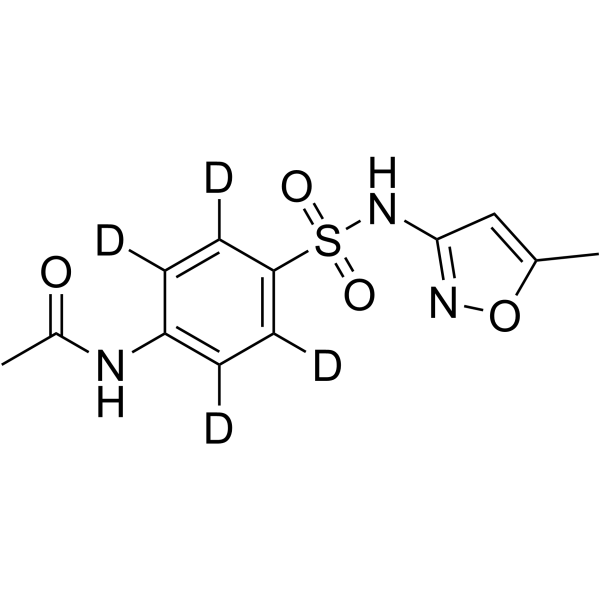
-
- HY-B0510S
-
|
|
Antifolate
Bacterial
Antibiotic
|
Infection
|
|
Trimethoprim-d9 is the deuterium labeled Trimethoprim. Trimethoprim is a bacteriostatic antibiotic and an orally active dihydrofolate reductase inhibitor. Trimethoprim is active against a wide range of Gram-positive and Gram-negative aerobic bacteria. Trimethoprim has the potential for urinary tract infections, Shigellosis and Pneumocystis pneumonia treatment[1][2][3].
|
-
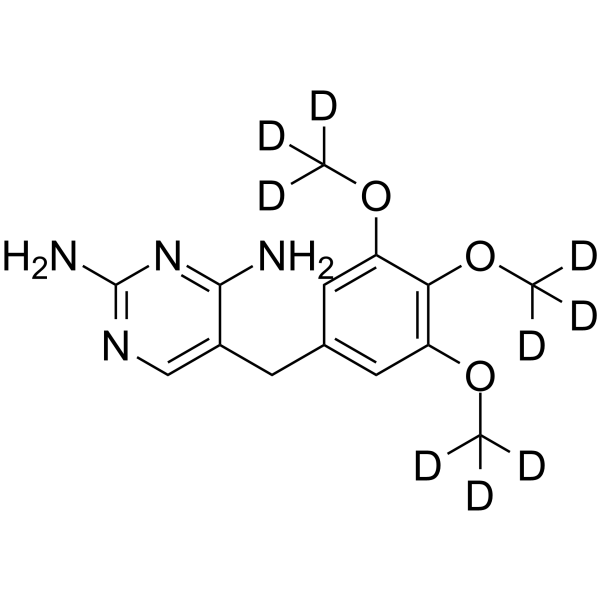
-
- HY-B1064A
-
|
Clindamycin 2-phosphate hydrochloride; U-28508 hydrochloride
|
Bacterial
Antibiotic
Parasite
|
Infection
|
|
Clindamycin phosphate (Clindamycin 2-phosphate) hydrochloride is a broad-spectrum bacteriostatic lincosamide antibiotic. Clindamycin phosphate hydrochloride is the proagent of Clindamycin (HY-B1455) with no antimicrobial activity in vitro but can be rapidly converted in vivo to the active parent agent, Clindamycin, by phosphatase ester hydrolysis. Clindamycin phosphate hydrochloride can be used for researching acne and bacterial vaginosis .
|
-
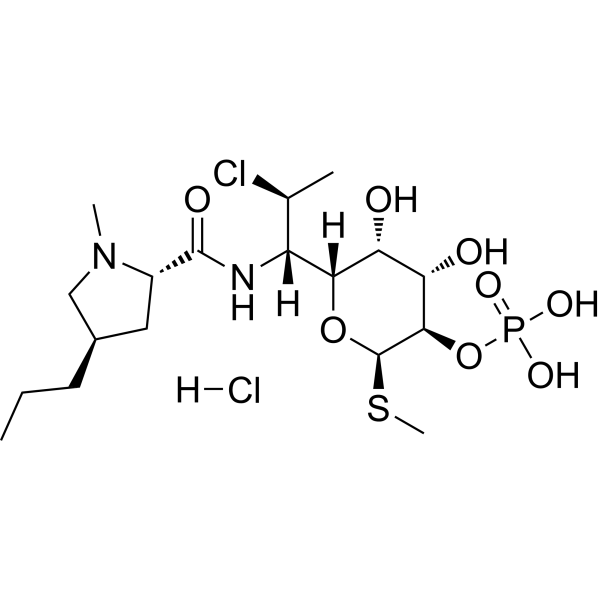
-
- HY-B1150
-
|
|
Bacterial
SARS-CoV
Antibiotic
|
Infection
Cancer
|
|
Clofoctol is a bacteriostatic antibiotic. Clofoctol is used in the treatment of respiratory tract and ear, nose and throat infections caused by Gram-positive bacteria. Clofoctol is only functional against Gram-positive bacteria and can penetrate into human lung tissue. Clofoctol is also an inhibitor of prostate cancer. Clofoctol has antiviral potency .
|
-

-
- HY-B0510S2
-
|
|
Antifolate
Bacterial
Antibiotic
|
Infection
|
|
Trimethoprim-d3is the deuterium labeled Trimethoprim. Trimethoprim is a bacteriostatic antibiotic and an orally active dihydrofolate reductase inhibitor. Trimethoprim is active against a wide range of Gram-positive and Gram-negative aerobic bacteria. Trimethoprim has the potential for urinary tract infections, Shigellosis and Pneumocystis pneumonia treatment[1][2][3].
|
-
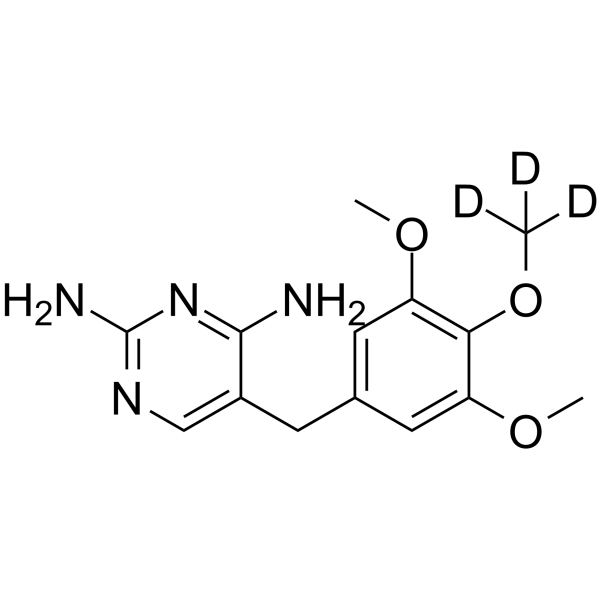
-
- HY-B1350S
-
|
Fusidate-d6; SQ-16603-d6
|
Bacterial
Antibiotic
|
Infection
|
|
Fusidic acid-d6 is the deuterium labeled Fusidic acid. Fusidic acid (Fusidate) a bacteriostatic antibiotic produced from the Fusidium coccineum fungus, belongs to the class of steroids. Fusidic acid has no corticosteroid effects. Fusidic acid inhibits the growth of bacteria by preventing the release of translation elongation factor G (EF-G) from the ribosome[1][2].
|
-
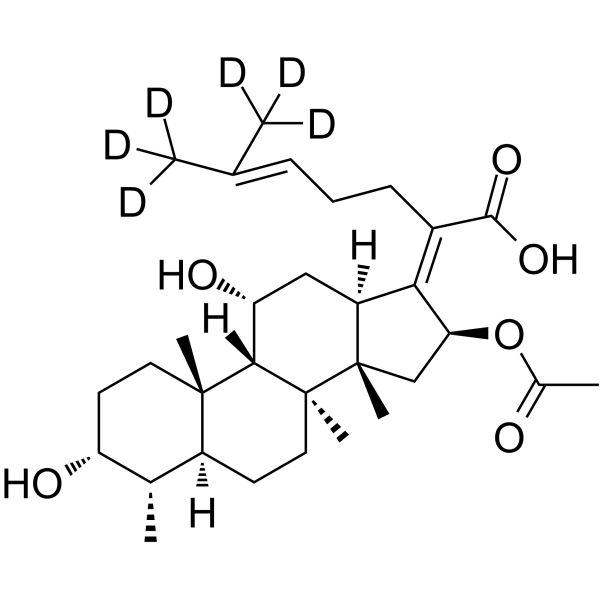
-
- HY-17412S1
-
|
|
Isotope-Labeled Compounds
|
Infection
Neurological Disease
Inflammation/Immunology
Cancer
|
|
Minocycline-d6 sulfate is deuterated labeled Minocycline (HY-17412A). Minocycline is an orally effective semi-synthetic tetracycline antibiotic and HIF-1α inhibitor that can penetrate the blood-brain barrier. Minocycline has bacteriostatic, anti-cancer, anti-inflammatory, neuroprotective properties and antidepressant effects.
|
-
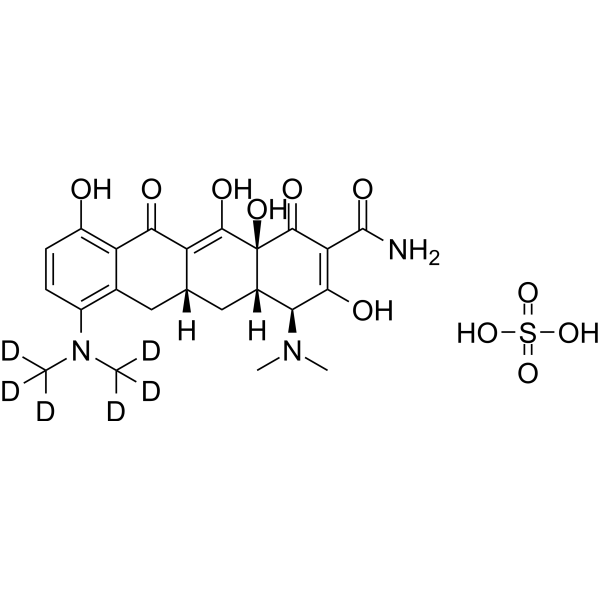
-
- HY-B0510
-
|
|
Antifolate
Bacterial
Antibiotic
Influenza Virus
|
Infection
|
|
Trimethoprim is a bacteriostatic antibiotic and an orally active dihydrofolate reductase inhibitor. Trimethoprim is active against a wide range of Gram-positive and Gram-negative aerobic bacteria. Trimethoprim has the potential for the research of urinary tract infections, Shigellosis and Pneumocystis pneumonia. Trimethoprim can inhibit infection of Influenza A virus in chick embryo when combinated with zinc .
|
-
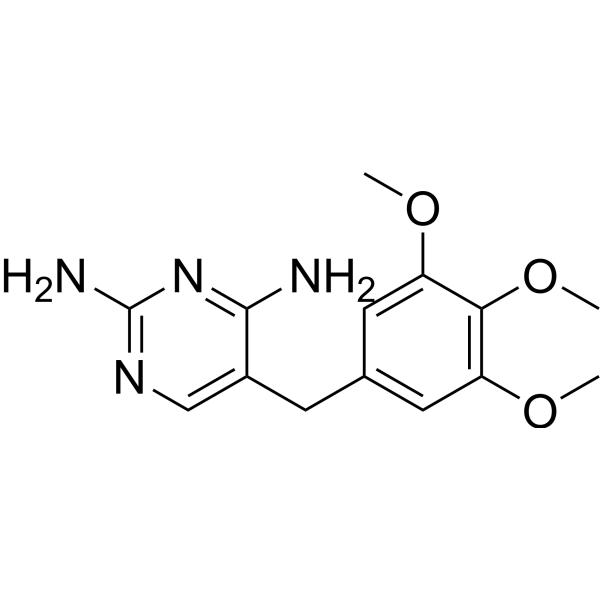
-
- HY-B0398S
-
|
|
Bacterial
Antibiotic
Topoisomerase
|
Infection
|
|
Nalidixic Acid-d5 is the deuterium labeled Nalidixic acid. Nalidixic acid, a quinolone antibiotic, is effective against both gram-positive and gram-negative bacteria. Nalidixic acid acts in a bacteriostatic manner in lower concentrations and is bactericidal in higher concentrations. Nalidixic acid inhibits a subunit of DNA gyrase and topoisomerase IV and reversibly blocks DNA replication in susceptible bacteria[1].
|
-
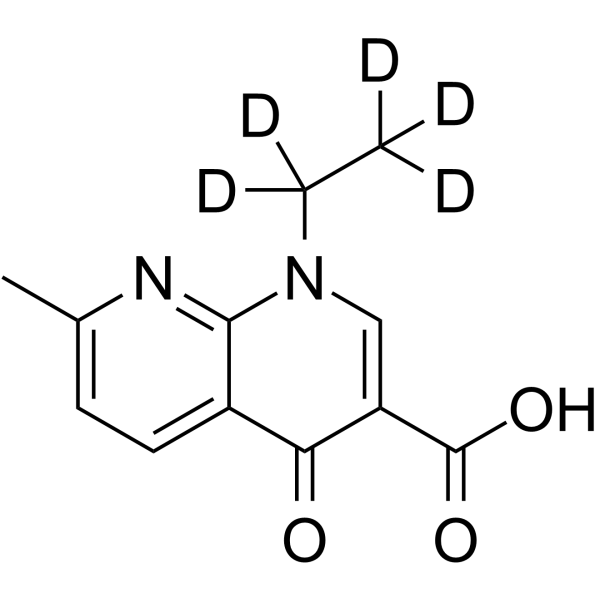
-
- HY-B0510B
-
|
|
Antifolate
Bacterial
Antibiotic
Influenza Virus
|
Infection
|
|
Trimethoprim hydrochloride is a bacteriostatic antibiotic and an orally active dihydrofolate reductase inhibitor. Trimethoprim hydrochloride is active against a wide range of Gram-positive and Gram-negative aerobic bacteria. Trimethoprim hydrochloride has the potential for the research of urinary tract infections, Shigellosis and Pneumocystis pneumonia. Trimethoprim hydrochloride can inhibit infection of Influenza A virus in chick embryo when combinated with zinc .
|
-
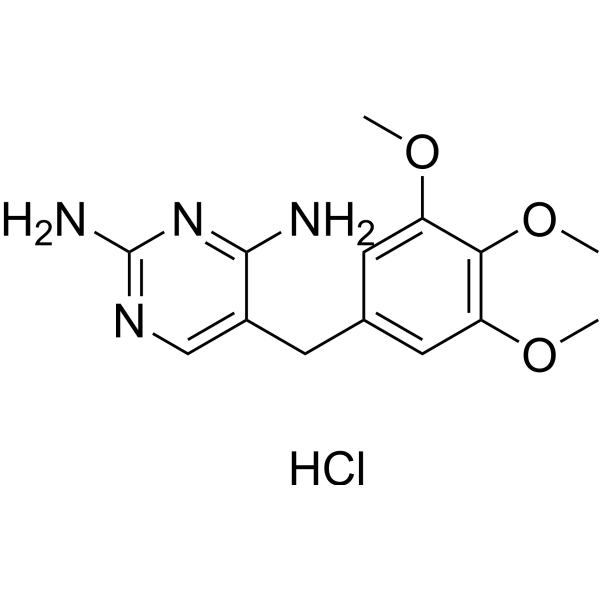
-
- HY-B1350R
-
|
Fusidate (Standard); SQ-16603 (Standard)
|
Antibiotic
Bacterial
|
Cancer
|
|
Fusidic acid (Standard) is the analytical standard of Fusidic acid. This product is intended for research and analytical applications. Fusidic acid (Fusidate) a bacteriostatic antibiotic produced from the Fusidium coccineum fungus, belongs to the class of steroids. Fusidic acid has no corticosteroid effects. Fusidic acid inhibits the growth of bacteria by preventing the release of translation elongation factor G (EF-G) from the ribosome .
|
-
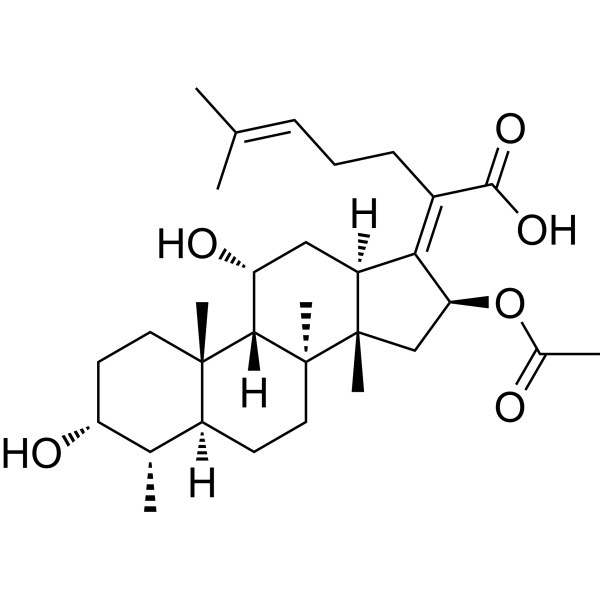
-
- HY-B0479R
-
|
Thiophenicol (Standard); Dextrosulphenidol (Standard)
|
Beta-lactamase
Bacterial
Antibiotic
|
Infection
|
|
Thiamphenicol (Standard) is the analytical standard of Thiamphenicol. This product is intended for research and analytical applications. Thiamphenicol (Thiophenicol), a methyl-sulfonyl derivative of Chloramphenicol, is a broad-spectrum antimicrobial antibiotic. Thiamphenicol acts by binding to the 50S ribosomal subunit, leading to inhibition of protein synthesis and bacteriostatic effect (against Gram-negative, Gram-positive aerobic and anaerobic bacteria) .
|
-
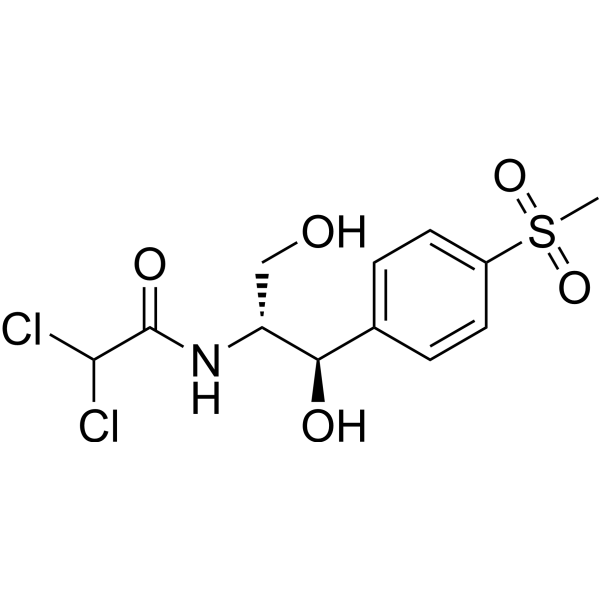
-
- HY-B0688
-
|
4,4′-Diaminodiphenyl sulfone; DDS
|
Antibiotic
Parasite
Bacterial
Reactive Oxygen Species
|
Infection
Inflammation/Immunology
|
|
Dapsone (4,4′-Diaminodiphenyl sulfone) is an orally active and blood-brain penetrant sulfonamide antibiotic with bacteriostatic, antimycobacterial and antiprotozoal activities . Dapsone exerts effective antileprosy activity and inhibits folate synthesis in cell extracts of M. leprae. Dapsone is used for dermatologic disorder research, including leprosy, dermatitis herpetiformis, acne vulgaris et al .
|
-
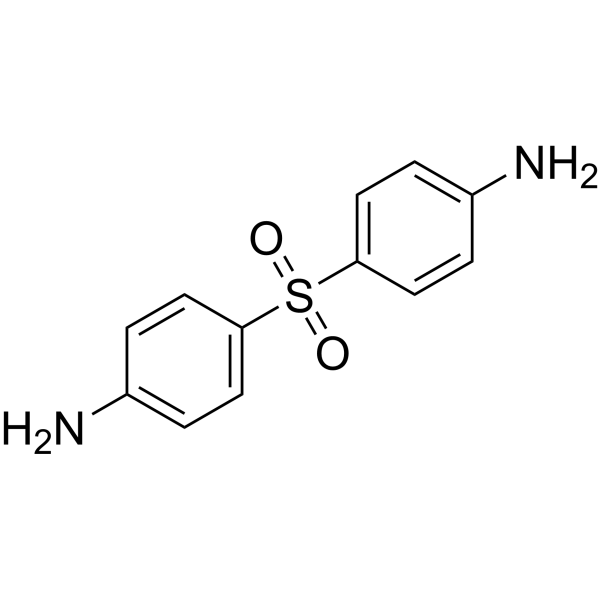
-
- HY-B0510C
-
|
|
Antifolate
Bacterial
Antibiotic
|
Infection
|
|
Trimethoprim lactate is a bacteriostatic antibiotic and an orally active dihydrofolate reductase inhibitor. Trimethoprim lactate is active against a wide range of Gram-positive and Gram-negative aerobic bacteria. Trimethoprim lactate has the potential for the research of urinary tract infections, Shigellosis and Pneumocystis pneumonia. Trimethoprim lactate can inhibit infection of Influenza A virus in chick embryo when combinated with zinc .
|
-
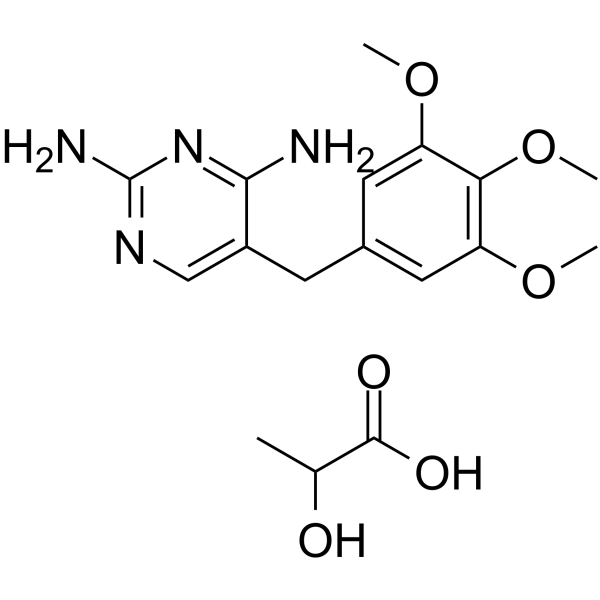
-
- HY-B0510A
-
|
|
Antifolate
Bacterial
Antibiotic
Influenza Virus
|
Infection
|
|
Trimethoprim sulfate is a bacteriostatic antibiotic and an orally active dihydrofolate reductase inhibitor. Trimethoprim sulfate is active against a wide range of Gram-positive and Gram-negative aerobic bacteria. Trimethoprim sulfate has the potential for the research of urinary tract infections, Shigellosis and Pneumocystis pneumonia. Trimethoprim sulfate can inhibit infection of Influenza A virus in chick embryo when combinated with zinc .
|
-
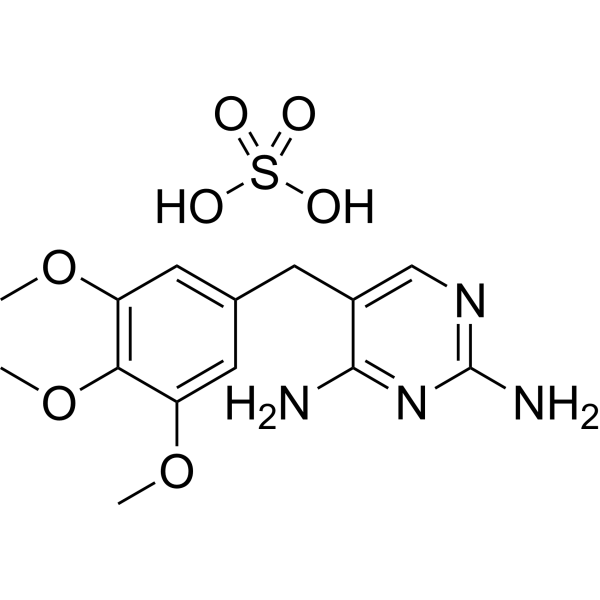
-
- HY-B1064R
-
|
Clindamycin 2-phosphate (Standard); U-28508 (Standard)
|
Bacterial
Antibiotic
Parasite
|
Infection
|
|
Clindamycin phosphate (Standard) is the analytical standard of Clindamycin phosphate. This product is intended for research and analytical applications. Clindamycin phosphate (Clindamycin 2-phosphate) is a broad-spectrum bacteriostatic lincosamide antibiotic. Clindamycin phosphate is the proagent of Clindamycin (HY-B1455) with no antimicrobial activity in vitro but can be rapidly converted in vivo to the active parent agent, Clindamycin, by phosphatase ester hydrolysis. Clindamycin phosphate can be used for researching acne and bacterial vaginosis .
|
-
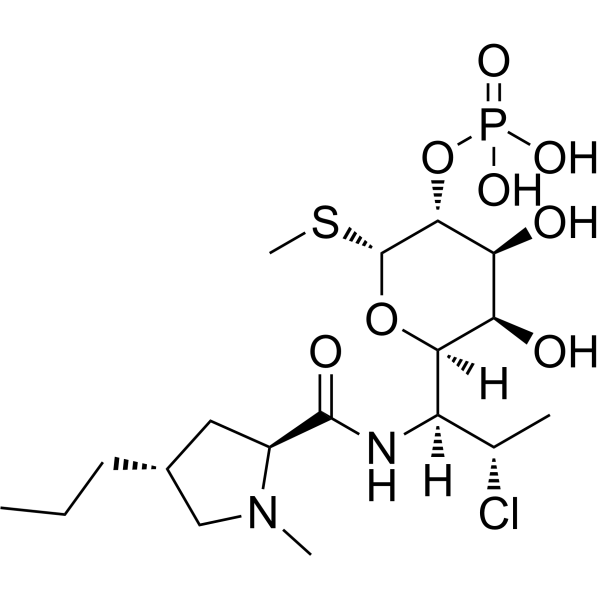
-
- HY-B1455
-
|
|
|
|
|
Clindamycin is an orally active and broad-spectrum bacteriostatic lincosamide antibiotic. Clindamycin can inhibit bacterial protein synthesis, possessing the ability to suppress the expression of virulence factors in Staphylococcus aureus at sub-inhibitory concentrations (sub-MICs). Clindamycin resistance results from enzymatic methylation of the antibiotic binding site in the 50S ribosomal subunit (23S rRNA). Clindamycin decreases the production of Panton-Valentine leucocidin (PVL), toxic-shock-staphylococcal toxin (TSST-1) or alpha-haemolysin (Hla). Clindamycin also can be used for researching malaria .
|
-

-
- HY-B0510S3
-
|
|
Isotope-Labeled Compounds
|
Others
|
|
Trimethoprim- 13C3is the deuterium labeledTrimethoprim(HY-B0510) . Trimethoprim is a bacteriostatic antibiotic and an orally active dihydrofolate reductase inhibitor. Trimethoprim is active against a wide range of Gram-positive and Gram-negative aerobic bacteria. Trimethoprim has the potential for the research of urinary tract infections, Shigellosis and Pneumocystis pneumonia. Trimethoprim can inhibit infection of Influenza A virus in chick embryo when combinated with zinc .
|
-
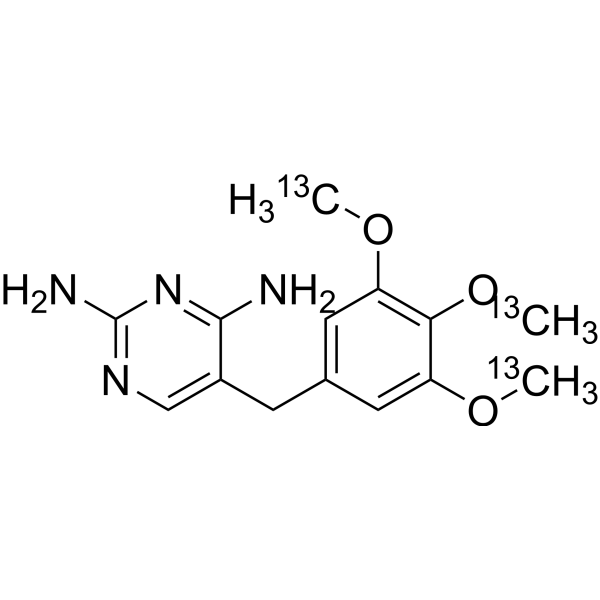
-
- HY-B1064
-
|
Clindamycin 2-phosphate; U-28508
|
Bacterial
Antibiotic
Parasite
|
Infection
|
|
Clindamycin phosphate (Clindamycin 2-phosphate) is a broad-spectrum bacteriostatic lincosamide antibiotic. Clindamycin phosphate is the proagent of Clindamycin (HY-B1455) with no antimicrobial activity in vitro but can be rapidly converted in vivo to the active parent agent, Clindamycin, by phosphatase ester hydrolysis. Clindamycin phosphate can be used for researching acne and bacterial vaginosis .Clindamycin phosphate has no cytotoxicity。 Combined with platelet rich fibrin (PRF), PRF-Clindamycin phosphate enhances antimicrobial properties .
|
-

-
- HY-B0688S1
-
|
4,4′-Diaminodiphenyl sulfone-d4; DDS-d4
|
Antibiotic
Parasite
Bacterial
Reactive Oxygen Species
|
Infection
Inflammation/Immunology
|
|
Dapsone-d4 is the deuterium labeled Dapsone. Dapsone (4,4′-Diaminodiphenyl sulfone) is an orally active and blood-brain penetrant sulfonamide antibiotic with bacteriostatic, antimycobacterial and antiprotozoal activities[1]. Dapsone exerts effective antileprosy activity and inhibits folate synthesis in cell extracts of M. leprae. Dapsone is used for dermatologic disorder research, including leprosy, dermatitis herpetiformis, acne vulgaris et al[2][3].
|
-

-
- HY-B1455S
-
|
|
Bacterial
Antibiotic
Parasite
|
Infection
|
|
Clindamycin-d3 (hydrochloride) is the deuterium labeled Clindamycin. Clindamycin is an orally active and broad-spectrum bacteriostatic lincosamide antibiotic. Clindamycin can inhibit bacterial protein synthesis, possessing the ability to suppress the expression of virulence factors in Staphylococcus aureus at sub-inhibitory concentrations (sub-MICs). Clindamycin resistance results from enzymatic methylation of the antibiotic binding site in the 50S ribosomal subunit (23S rRNA). Clindamycin decreases the production of Panton-Valentine leucocidin (PVL), toxic-shock-staphylococcal toxin (TSST-1) or alpha-haemolysin (Hla). Clindamycin also can be used for researching malaria[1][2].
|
-

-
- HY-B0479S1
-
|
Thiophenicol-d3-1; Dextrosulphenidol-d3-1
|
Isotope-Labeled Compounds
|
Infection
|
|
Thiamphenicol-d3-1 (Thiophenicol-d3-1; Dextrosulphenidol-d3-1) is the deuterium-labeled Thiamphenicol (HY-B0479) . Thiamphenicol (Thiophenicol), a methyl-sulfonyl derivative of Chloramphenicol, is a broad-spectrum antimicrobial antibiotic. Thiamphenicol acts by binding to the 50S ribosomal subunit, leading to inhibition of protein synthesis and bacteriostatic effect (against Gram-negative, Gram-positive aerobic and anaerobic bacteria) .
|
-

-
- HY-B1455S1
-
|
|
Isotope-Labeled Compounds
Bacterial
Antibiotic
Parasite
|
Infection
|
|
Clindamycin- 13C,d3 is the 13C- and deuterium labeled Clindamycin. Clindamycin is an orally active and broad-spectrum bacteriostatic lincosamide antibiotic. Clindamycin can inhibit bacterial protein synthesis, possessing the ability to suppress the expression of virulence factors in Staphylococcus aureus at sub-inhibitory concentrations (sub-MICs). Clindamycin resistance results from enzymatic methylation of the antibiotic binding site in the 50S ribosomal subunit (23S rRNA). Clindamycin decreases the production of Panton-Valentine leucocidin (PVL), toxic-shock-staphylococcal toxin (TSST-1) or alpha-haemolysin (Hla). Clindamycin also can be used for researching malaria[1][2][3].
|
-

-
- HY-17412
-
-

-
- HY-B0688S2
-
|
4,4′-Diaminodiphenyl sulfone-13C12; DDS-13C12
|
Isotope-Labeled Compounds
Antibiotic
Parasite
Bacterial
Reactive Oxygen Species
|
Infection
Inflammation/Immunology
|
|
Dapsone- 13C12 is the 13C12 labeled Dapsone (HY-B0688). Dapsone (4,4′-Diaminodiphenyl sulfone) is an orally active and blood-brain penetrant sulfonamide antibiotic with bacteriostatic, antimycobacterial and antiprotozoal activities. Dapsone exerts effective antileprosy activity and inhibits folate synthesis in cell extracts of M. leprae. Dapsone is used for dermatologic disorder research, including leprosy, dermatitis herpetiformis, acne vulgaris et al .
|
-

-
- HY-17412A
-
-

-
- HY-17412R
-
-
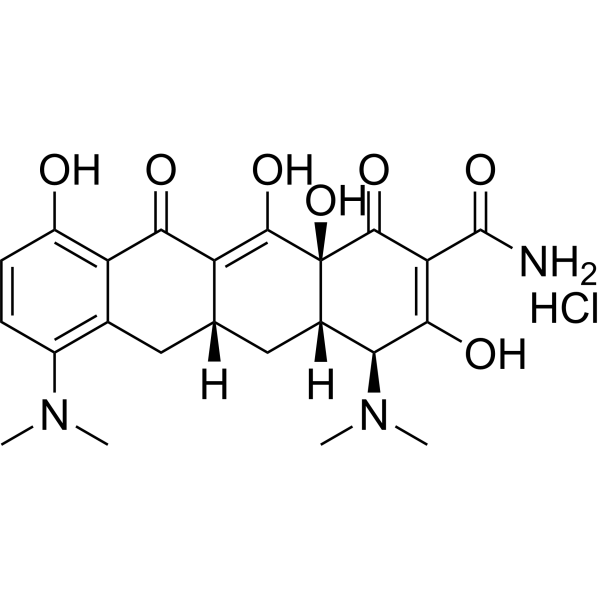
| Cat. No. |
Product Name |
Category |
Target |
Chemical Structure |
| Cat. No. |
Product Name |
Chemical Structure |
-
- HY-B0322S1
-
|
|
|
Sulfamethoxazole- 13C6 is a 13C labeled Sulfamethoxazole. Sulfamethoxazole (Ro 4-2130) is a sulfonamide bacteriostatic antibiotic, used for bacterial infections. Sulfonamides is a competitive antagonist of para-aminobenzoic acid (PABA)[1].
|
-

-
- HY-B0479S
-
|
|
|
Thiamphenicol-d3 is a deuterium labeled Thiamphenicol. Thiamphenicol, a methyl-sulfonyl derivative of Chloramphenicol, is a broad-spectrum antimicrobial antibiotic. Thiamphenicol acts by binding to the 50S ribosomal subunit, leading to inhibition of protein synthesis and bacteriostatic effect (against Gram-negative, Gram-positive aerobic and anaerobic bacteria)[1][2].
|
-

-
- HY-B0322S
-
1 Publications Verification
|
|
Sulfamethoxazole-d4 is a deuterium labeled Sulfamethoxazole (Ro 4-2130). Sulfamethoxazole is a sulfonamide bacteriostatic antibiotic[1].
|
-

-
- HY-N7123S1
-
|
|
|
Sulfacetamide- 13C6 is the 13C6 labeled Sulfacetamide. Sulfacetamide (Sulphacetamide), a bacteriostatic sulphonamide, is a popular antibiotic prescribed for treating ocular infections.
|
-

-
- HY-N7123S
-
|
|
|
Sulfacetamide-d4 is the deuterium labeled Sulfacetamide. Sulfacetamide (Sulphacetamide), a bacteriostatic sulphonamide, is a popular antibiotic prescribed for treating ocular infections[1][2].
|
-

-
- HY-19581S
-
|
|
|
Baquiloprim-d6 is deuterium labeled Baquiloprim. Baquiloprim, an antibiotic, is a selective inhibitor of bacterial dihydrofolate reductases. Baquiloprim possesses in vitro bacteriostatic activity against both Gram-negative and Gram-positive bacteria[1][2].
|
-

-
- HY-W013266S
-
|
|
|
N4-Acetylsulfamethoxazole-d4 is the deuterium labeled N4-Acetylsulfamethoxazole. N4-Acetylsulfamethoxazole (Acetylsulfamethoxazole) is a metabolite of Sulfamethoxazole (HY-B0322). Sulfamethoxazole is a sulfonamide bacteriostatic antibiotic, used for bacterial infections[1].
|
-

-
- HY-B0510S
-
|
|
|
Trimethoprim-d9 is the deuterium labeled Trimethoprim. Trimethoprim is a bacteriostatic antibiotic and an orally active dihydrofolate reductase inhibitor. Trimethoprim is active against a wide range of Gram-positive and Gram-negative aerobic bacteria. Trimethoprim has the potential for urinary tract infections, Shigellosis and Pneumocystis pneumonia treatment[1][2][3].
|
-

-
- HY-B0510S2
-
|
|
|
Trimethoprim-d3is the deuterium labeled Trimethoprim. Trimethoprim is a bacteriostatic antibiotic and an orally active dihydrofolate reductase inhibitor. Trimethoprim is active against a wide range of Gram-positive and Gram-negative aerobic bacteria. Trimethoprim has the potential for urinary tract infections, Shigellosis and Pneumocystis pneumonia treatment[1][2][3].
|
-

-
- HY-B1350S
-
|
|
|
Fusidic acid-d6 is the deuterium labeled Fusidic acid. Fusidic acid (Fusidate) a bacteriostatic antibiotic produced from the Fusidium coccineum fungus, belongs to the class of steroids. Fusidic acid has no corticosteroid effects. Fusidic acid inhibits the growth of bacteria by preventing the release of translation elongation factor G (EF-G) from the ribosome[1][2].
|
-

-
- HY-17412S1
-
|
|
|
Minocycline-d6 sulfate is deuterated labeled Minocycline (HY-17412A). Minocycline is an orally effective semi-synthetic tetracycline antibiotic and HIF-1α inhibitor that can penetrate the blood-brain barrier. Minocycline has bacteriostatic, anti-cancer, anti-inflammatory, neuroprotective properties and antidepressant effects.
|
-

-
- HY-B0398S
-
|
|
|
Nalidixic Acid-d5 is the deuterium labeled Nalidixic acid. Nalidixic acid, a quinolone antibiotic, is effective against both gram-positive and gram-negative bacteria. Nalidixic acid acts in a bacteriostatic manner in lower concentrations and is bactericidal in higher concentrations. Nalidixic acid inhibits a subunit of DNA gyrase and topoisomerase IV and reversibly blocks DNA replication in susceptible bacteria[1].
|
-

-
- HY-B0510S3
-
|
|
|
Trimethoprim- 13C3is the deuterium labeledTrimethoprim(HY-B0510) . Trimethoprim is a bacteriostatic antibiotic and an orally active dihydrofolate reductase inhibitor. Trimethoprim is active against a wide range of Gram-positive and Gram-negative aerobic bacteria. Trimethoprim has the potential for the research of urinary tract infections, Shigellosis and Pneumocystis pneumonia. Trimethoprim can inhibit infection of Influenza A virus in chick embryo when combinated with zinc .
|
-

-
- HY-B0688S1
-
|
|
|
Dapsone-d4 is the deuterium labeled Dapsone. Dapsone (4,4′-Diaminodiphenyl sulfone) is an orally active and blood-brain penetrant sulfonamide antibiotic with bacteriostatic, antimycobacterial and antiprotozoal activities[1]. Dapsone exerts effective antileprosy activity and inhibits folate synthesis in cell extracts of M. leprae. Dapsone is used for dermatologic disorder research, including leprosy, dermatitis herpetiformis, acne vulgaris et al[2][3].
|
-

-
- HY-B1455S
-
|
|
|
Clindamycin-d3 (hydrochloride) is the deuterium labeled Clindamycin. Clindamycin is an orally active and broad-spectrum bacteriostatic lincosamide antibiotic. Clindamycin can inhibit bacterial protein synthesis, possessing the ability to suppress the expression of virulence factors in Staphylococcus aureus at sub-inhibitory concentrations (sub-MICs). Clindamycin resistance results from enzymatic methylation of the antibiotic binding site in the 50S ribosomal subunit (23S rRNA). Clindamycin decreases the production of Panton-Valentine leucocidin (PVL), toxic-shock-staphylococcal toxin (TSST-1) or alpha-haemolysin (Hla). Clindamycin also can be used for researching malaria[1][2].
|
-

-
- HY-B0479S1
-
|
|
|
Thiamphenicol-d3-1 (Thiophenicol-d3-1; Dextrosulphenidol-d3-1) is the deuterium-labeled Thiamphenicol (HY-B0479) . Thiamphenicol (Thiophenicol), a methyl-sulfonyl derivative of Chloramphenicol, is a broad-spectrum antimicrobial antibiotic. Thiamphenicol acts by binding to the 50S ribosomal subunit, leading to inhibition of protein synthesis and bacteriostatic effect (against Gram-negative, Gram-positive aerobic and anaerobic bacteria) .
|
-

-
- HY-B1455S1
-
|
|
|
Clindamycin- 13C,d3 is the 13C- and deuterium labeled Clindamycin. Clindamycin is an orally active and broad-spectrum bacteriostatic lincosamide antibiotic. Clindamycin can inhibit bacterial protein synthesis, possessing the ability to suppress the expression of virulence factors in Staphylococcus aureus at sub-inhibitory concentrations (sub-MICs). Clindamycin resistance results from enzymatic methylation of the antibiotic binding site in the 50S ribosomal subunit (23S rRNA). Clindamycin decreases the production of Panton-Valentine leucocidin (PVL), toxic-shock-staphylococcal toxin (TSST-1) or alpha-haemolysin (Hla). Clindamycin also can be used for researching malaria[1][2][3].
|
-

-
- HY-B0688S2
-
|
|
|
Dapsone- 13C12 is the 13C12 labeled Dapsone (HY-B0688). Dapsone (4,4′-Diaminodiphenyl sulfone) is an orally active and blood-brain penetrant sulfonamide antibiotic with bacteriostatic, antimycobacterial and antiprotozoal activities. Dapsone exerts effective antileprosy activity and inhibits folate synthesis in cell extracts of M. leprae. Dapsone is used for dermatologic disorder research, including leprosy, dermatitis herpetiformis, acne vulgaris et al .
|
-

Your information is safe with us. * Required Fields.
Inquiry Information
- Product Name:
- Cat. No.:
- Quantity:
- MCE Japan Authorized Agent:


























































